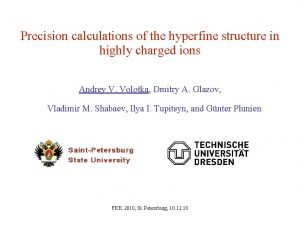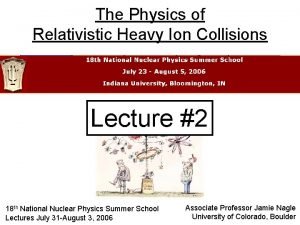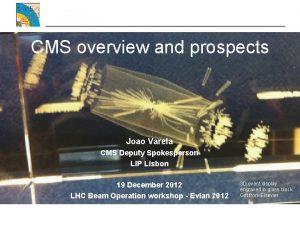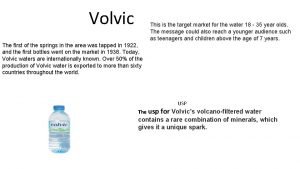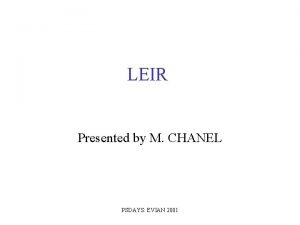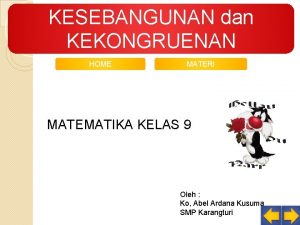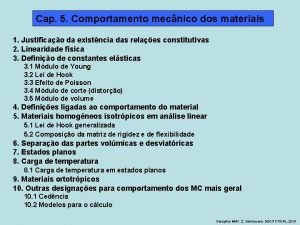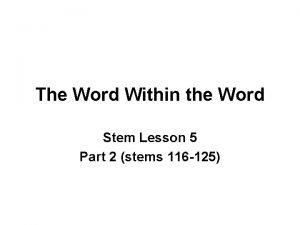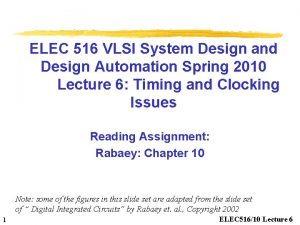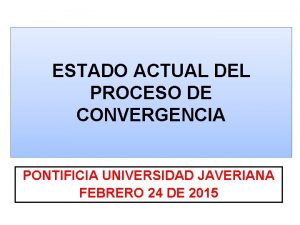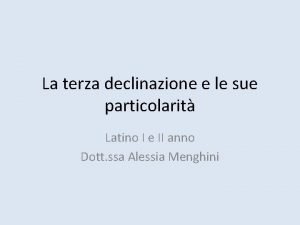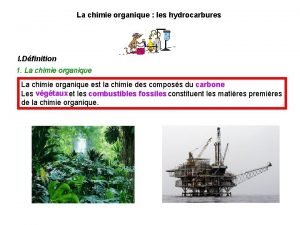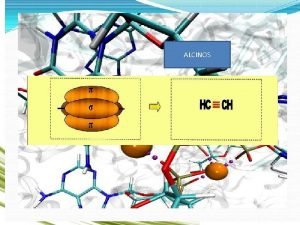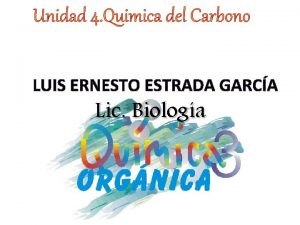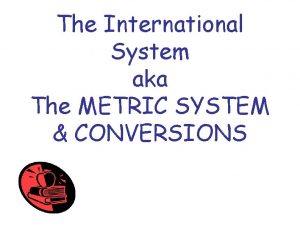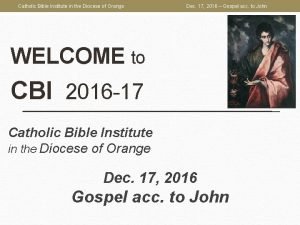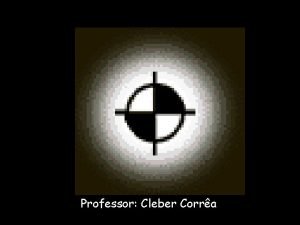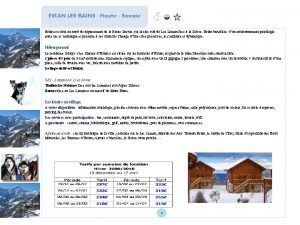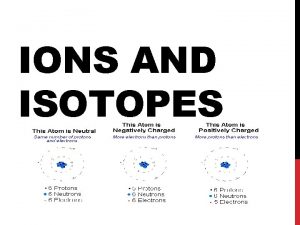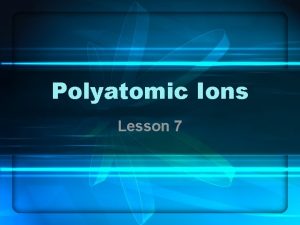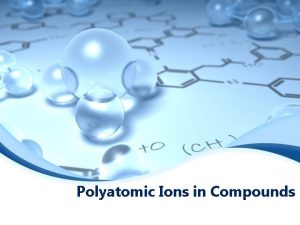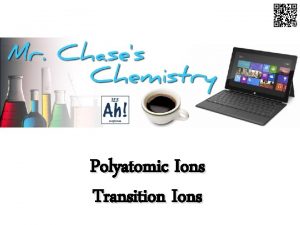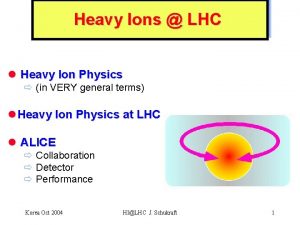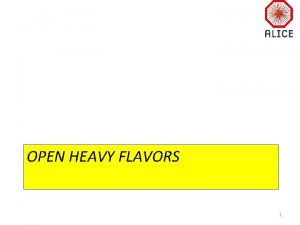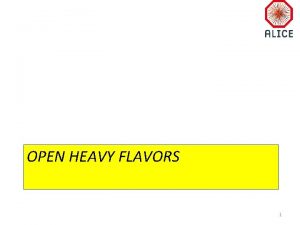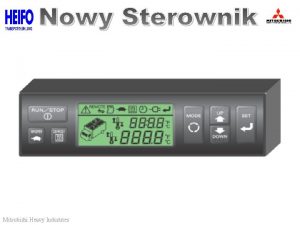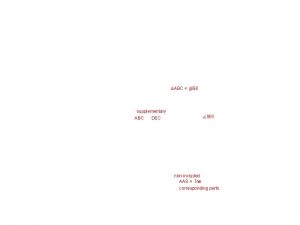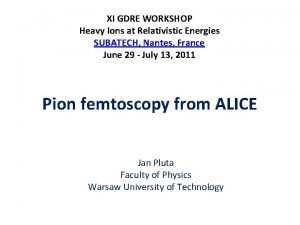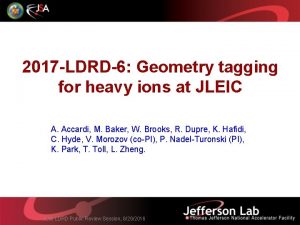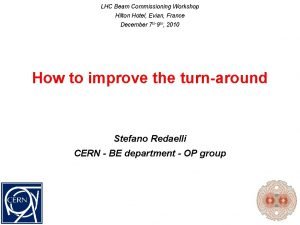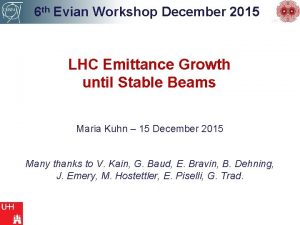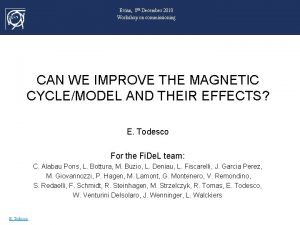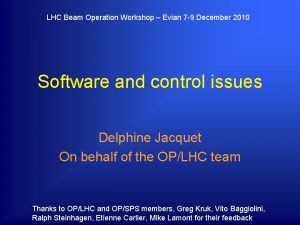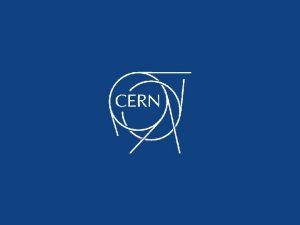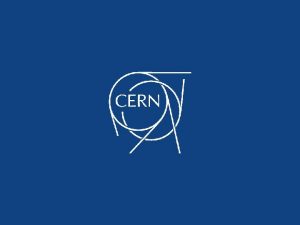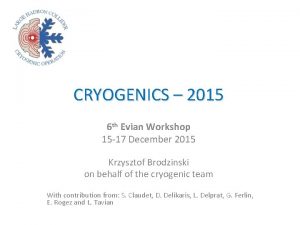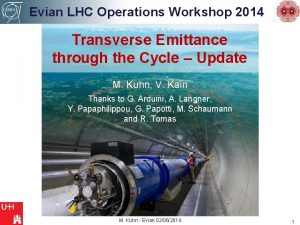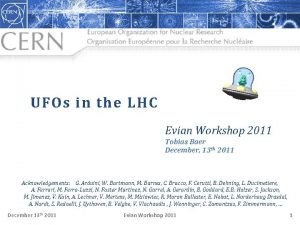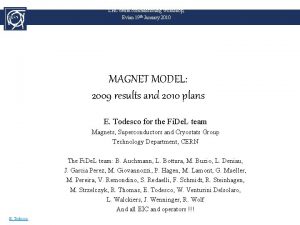14 Dec 2017 Evian Workshop Heavy Ions in


























- Slides: 26

14 Dec 2017, Evian Workshop Heavy Ions in 2018 Michaela Schaumann & J. M. Jowett Special Thanks: R. Allemany, H. Bartosik, J. Boyd, S. Fartoukh, C. Schwick, M. Solfaroli, J. Wenninger CMS event display showing one of the first Xe-Xe collisions in the LHC (2017 -Oct-12)

Outline • • Run Schedule Machine configuration • • • Expected Beams • • • Beam production in the injectors Bunch parameters Performance Predictions • • Optics (Ramp & Squeeze, β* reach) Energy Integrated luminosity projections Luminosity levelling options BFPP bumps (quench mitigation) Conclusions 14/12/2017 M. Schaumann - Heavy Ions in 2018 2

Setting the Scene • 2018 will be only the 4 th Pb-Pb run (2 nd in Run 2) • • Full one-month run will be the last physics before LS 2 Board goal is to fulfil the “initial 10 years” LHC design goal of 1 nb-1 Pb-Pb luminosity for ALICE, ATLAS and CMS Studies and discussions are on-going • • 2010 Pb-Pb Since 2013 all 4 main experiments have participated in data taking Not all run configurations can be decided yet Presenting current status and possible options 2011 Pb-Pb 14/12/2017 2013 p-Pb LS 1 2015 Pb-Pb 2016 p-Pb 2017 Xe-Xe M. Schaumann - Heavy Ions in 2018 Pb-Pb LS 2 3

Run Schedule • • • TS 3 for re-installation of ZDC in ATLAS/CMS 4 days commissioning (starting form Sunday) 25 days of physics operation • • • 1 -2 days of MD • • Intensity ramp-up similar to previous years Maximum number of bunches 500 -600 Crystal Collimation Secondary beam (BFPP) induced quench test Potentially other things to be tested before LS 2 ALICE polarity reversal, ion source refill, van der Meer Scans, … 14/12/2017 M. Schaumann - Heavy Ions in 2018 4

6. 37 Z Te. V Beam Energy Reduction of the beam energy from 6. 5 Z Te. V to 6. 37 Z Te. V provided the possibility to compare all collision modes at the same centre-of-mass energy per colliding nucleon pair: √s. NN = 5. 02 Te. V p-p Eb = 2. 51 Te. V ( 2015/17 ) 14/12/2017 p-Pb Eb = 4 Z Te. V ( 2013/16) Pb-Pb Eb = 6. 37 Z Te. V ( 2015/18 ) M. Schaumann - Heavy Ions in 2018 5

Optics Configuration • As usual we want to make the most rapid and efficient transition from p-p to Pb-Pb configuration • Main differences to p-p: • • • Different beam energy: 6. 37 Z Te. V instead of 6. 5 Z Te. V Must squeeze ALICE and LHCb further than in p-p No telescopic squeeze (judgement: simplicity, risk, time) 14/12/2017 M. Schaumann - Heavy Ions in 2018 6

Options for Ramp & Squeeze (R&S) 1) Prepare one combined R&S for p-p and Pb-Pb to reach β* of (IP 1, IP 2, IP 5, IP 8) = (1, 2, 1, 2) m + avoid commissioning of new combined R&S for Pb run + small squeeze segment from 2 m to 0. 5 m at top energy - can ALICE accept 2 m for proton run? - more initial commissioning to be done in p-p - coupling of p-p to Pb-Pb configuration 2) Keep ALICE at 10 m in R&S (IP 1, IP 2, IP 5, IP 8) = (1, 10, 1, 3) m - long IR 2 squeeze from 10 m to 0. 5 m to be done at top energy for each fill 3) As 1) but commissioning during Pb-Pb run (IP 1, IP 2, IP 5, IP 8) = (1, 2, 1, 2) m + small squeeze segment from 2 m to 0. 5 m at top energy + decouple p-p and Pb-Pb run configurations + more time to prepare missing optics files - more Pb-Pb commissioning time 14/12/2017 M. Schaumann - Heavy Ions in 2018 Pr efe rre d Op tio n 7

Collision Optics Baseline: • Crossing angles as in p-p except for ALICE • ALICE at 60μrad for efficiency of ZDC [=135μrad external] • ALICE / ATLAS / CMS at same β* • • Final choice depends on available aperture Considered options: β*= 0. 8 m, 0. 6 m or 0. 5 m • LHCb: β* = 2 – 1. 5 m (aperture depends on polarity) Optics for ALICE squeeze sequence still to be prepared: • • • S. Fartoukh Preliminary optics for β* = 0. 5 m in ALICE are available With IP 2 ~vertical shift and crossing angles aperture is OK on paper Possibly confirm available aperture with measurements early in 2018 14/12/2017 M. Schaumann - Heavy Ions in 2018 8

Beam Production in the Injectors Best 2015 Bunch PS Batch Train 100 ns 150 ns LEIR: PS: SPS: 2 bunches 100 ns batch compression 12 PS-batches with 150 ns batch spacing LEIR: PS: SPS: Trains to LHC: 12 x 2 b = 24 b spaced by 100/150 ns PS Batch 2 bunches bunch splitting with 100 ns ≥ 6 PS-batches (to be decided) 150 ns batch spacing Shorter trains with same number of bunches and intensity per bunch. Train 100 ns 150 ns 14/12/2017 150 ns Trains to LHC: ≥ 6 x 4 b ≥ 24 b spaced by 100/150 ns 2018 Bunch 100 ns 150 ns M. Schaumann - Heavy Ions in 2018 9

LHC Filling Pattern Several improvements since 2015: • Best 2015 filling scheme had 518 bunches • • Shorter trains from injectors with same number of bunches and intensity per bunch • • • ² ² Colliding 492 b in ATLAS/CMS, 444 in ALICE, 24 in LHCb Optimization of SPS train length to reduce LHC injection gaps Train spacing reduction in LHC: 900 ns 800 ns Optimization of Abort Gap Keeper Less gaps more bunches to LHC compared to 2015 Different filling schemes can be used through the run, to help optimize luminosity sharing between experiments. Train Bunch PS Batch 100 ns 150 ns 14/12/2017 100 ns 150 ns M. Schaumann - Heavy Ions in 2018 10

Bunch Parameters Average bunch intensity again improved by ~10% in 2016: • Nb (2015) = 1. 96 x 108 • Nb (2016) = 2. 14 x 108 Design Intensity Emittances are around nominal value: • εn = 1. 5μm Assumption: Get best injector performance from 2016 from the beginning in 2018. 14/12/2017 M. Schaumann - Heavy Ions in 2018 11

Luminosity Evolution: Levelling Scenarios ALICE needs to be levelled at L = 1. 0 x 1027 cm-2 s-1 Estimates for β* = 50 cm • Highest luminosity potential • Longest ALICE levelling times ALICE 4 levelling scenarios in ATLAS/CMS are evaluated: ATLAS/CMS The lower IP 1/5 are levelled • the longer ALICE can level • the lower their luminosity 14/12/2017 M. Schaumann - Heavy Ions in 2018 12

Optimum Fill Length ALICE stops levelling ATLAS/CMS ALICE Average integrated luminosity per hour Assumptions: • 2. 5 h turn-around time • ALICE levelled at 1. 0 x 1027 cm-2 s-1 Optimal time in collisions • ALICE: > max. ALICE levelling time • ATLAS/CMS: < max. ALICE levelling time 14/12/2017 M. Schaumann - Heavy Ions in 2018 13

Integrated Luminosity Assumptions: • 2. 5 h turn-around time • 50% efficiency • 21 days of full physics operation ATLAS/CMS Highest integrated luminosity for ALICE, if ATLAS/CMS are levelled to the same value. ALICE IP 2 level Lint IP 2 Lint IP 1/5 1 x 1027 cm-2 s-1 620 μb-1 1280 μb-1 1. 3 x 1027 cm-2 s-1 740 μb-1 1300 μb-1 Gain +20% +1% Significant reduction in luminosity potential for ATLAS/CMS. Levelling ALICE at 1. 3 x 1027 cm-2 s-1 • ALICE could gain +20% • ATLAS/CMS small impact Values for IP 1/5 levelled at 3 x 1027 cm-2 s-1 14/12/2017 M. Schaumann - Heavy Ions in 2018 14

LHCb Luminosity Evolution Prediction for β*=1. 5 m and 2015 filling scheme with 24 colliding bunches • Request for 60 -70 bunches • Possible filling schemes have not yet been studied. • Luminosity sharing with other experiments to be taken into account. 14/12/2017 M. Schaumann - Heavy Ions in 2018 15

Secondary Beams created in the Collision Bound-free pair production (BFPP) Secondary beams impact in superconducting magnets downstream the interaction points. 208 -Pb-81+ 208 -Pb-82+ Has large interaction crosssection (>200 b) in Pb-Pb collisions and is the main contribution to fast luminosity burn-off. 14/12/2017 Deposited power exceeds quench limit. Luminosity limit found at L≈2. 5 e 27 cm -2 s-1 (≅50 W into magnet) M. Schaumann - Heavy Ions in 2018 16

Quench Risk Mitigation with Orbit Bumps Orbit bumps are used to move the secondary beam losses to a less vulnerable location in order to reduce risk of quench. Technique operationally used since 2015. w/o bump with bump dipole Careful setup of bumps in beginning of the run to achieve desired loss displacement. 14/12/2017 “missing quadrupole dipole” cryostat Particle losses M. Schaumann - Heavy Ions in 2018 17

Loss Pattern around the Ring Loss spikes around all IPs where ions collide … BFPP Collimation ATLAS 14/12/2017 ALICE CMS M. Schaumann - Heavy Ions in 2018 LHCb 18

Potential Intensity and Luminosity Limitation High loss rates observed in 2015: often reached warning level when arriving at top energy (DS in IR 7) and in collisions (BFPP) Arrival at Top Energy Carefully evaluation of BLM thresholds necessary before the run to avoid quenches without compromising availability. 14/12/2017 In Collisions M. Schaumann - Heavy Ions in 2018 19

Not to forget… • Before the run • • • Collimation simulations of expected losses in IR 7 for quench protection and spike identification Evaluation of BLM thresholds During the run • BSRT calibration 14/12/2017 M. Schaumann - Heavy Ions in 2018 20

Conclusion • Planning and studies are still on-going. All projections presented are still preliminary and subject to changes! • Aim for β* (IP 1, 2, 5, 8) = (0. 5, 1. 5) m • • ramp & squeeze to β* ≈ (1, 1, 1, 1. 5 -2) m small squeeze element at top energy • Peak luminosity could approach 5 x design value, mainly because of outstanding injector performance. • Potential limitation by too high losses in BFPP locations and IR 7. • All 4 main experiments are taking data. • Strong intensity burn-off from high luminosity experiments • More bunches for LHCb Luminosity sharing strategies have to be discussed. 14/12/2017 M. Schaumann - Heavy Ions in 2018 21

Back - up 14/12/2017 M. Schaumann - Heavy Ions in 2018 22

Luminosity Evolution 2015 Simulated peak agrees with ATLAS measurement CMS measured higher peak ALICE was levelled <1 h shorter than predicted. Possible Error Sources: • • kb=250 kb=426 14/12/2017 Van der Meer scans kb=474 Source Crystal refill coll. MD Initial emittances smaller than the assumed 1. 5μm. Unaccounted emittance blow-up. Additional losses during storage. ALICE BFPP polarity quench kb=513 reversal test ULO scan M. Schaumann - Heavy Ions in 2018 Quench test 23

Levelling Scenarios: Level ALICE @ 1. 3 e 27 Estimates for on β* = 50 cm • Highest luminosity potential • Longest ALICE levelling times • ALICE always levelled at L = 1. 3 x 1027 cm-2 s-1 • ATLAS/CMS levelled at 4 different values 14/12/2017 M. Schaumann - Heavy Ions in 2018 24

Levelling Scenarios: Level ALICE @ 1. 3 e 27 Average integrated luminosity per hour Assumptions: • 2. 5 h turn-around time • ALICE levelled at 1. 3 x 1027 cm-2 s-1 Higher levelling value in ALICE has relatively small effect on ATLAS/CMS Optimal time in collisions • ALICE: > max. ALICE levelling time • ATLAS/CMS: < max. ALICE levelling time 14/12/2017 M. Schaumann - Heavy Ions in 2018 25

IR 8 optics for LHCb in 2016 (p-Pb at 8 Te. V) IR 8 horizontal, We used only the “good” spectrometer polarity in 2016. Confirming if still OK in 2018. 26 J. M. Jowett, ABP-HSS meeting 6/12/2017
 What do the roman numerals in a cation's name indicate?
What do the roman numerals in a cation's name indicate? Heavy ions
Heavy ions Heavy ions
Heavy ions Heavy ions
Heavy ions What does ratey stand for
What does ratey stand for Evian
Evian Evian nordstrand
Evian nordstrand Target market for mineral water
Target market for mineral water Psdays
Psdays Materi kesebangunan dan kekongruenan
Materi kesebangunan dan kekongruenan Jauge outil fraisage
Jauge outil fraisage Dec fct unl
Dec fct unl Organic biochemistry
Organic biochemistry Ra dec
Ra dec 8th dec 2014
8th dec 2014 Word within a word list 11
Word within a word list 11 Dec alpha 21264
Dec alpha 21264 Dec. 3022/13
Dec. 3022/13 Declinazione di mare in latino
Declinazione di mare in latino Propylhexane formule semi-développée
Propylhexane formule semi-développée Met et prop but pent hex hept oct non dec
Met et prop but pent hex hept oct non dec Met et prop but pent hex hept oct non dec
Met et prop but pent hex hept oct non dec Alquinos mas importantes
Alquinos mas importantes Base units for metric system
Base units for metric system Jlh mesure
Jlh mesure Dec 17
Dec 17 Propil
Propil

